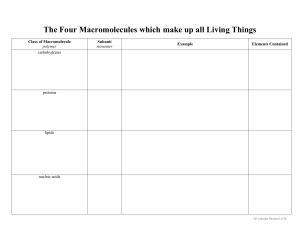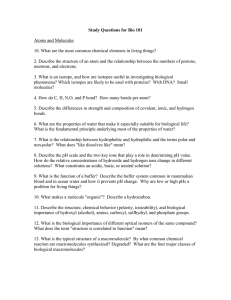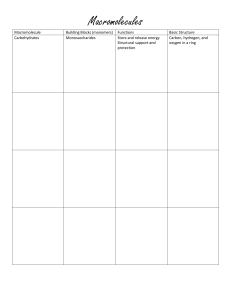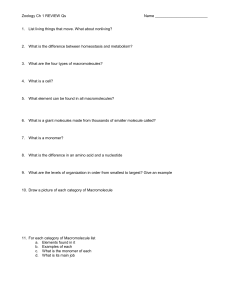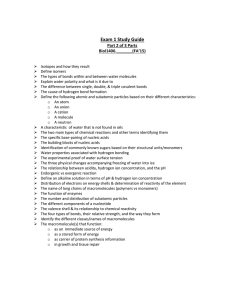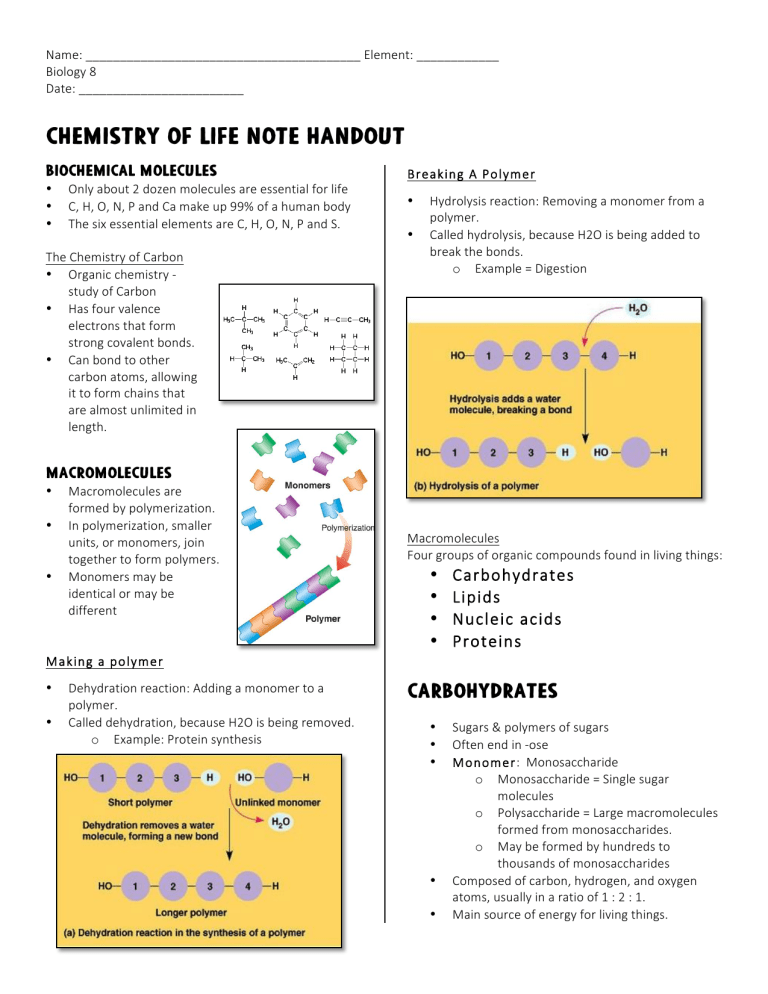
Name: ________________________________________ Element: ____________ Biology 8 Date: ________________________ Chemistry of Life note handout Biochemical Molecules • Only about 2 dozen molecules are essential for life • C, H, O, N, P and Ca make up 99% of a human body • The six essential elements are C, H, O, N, P and S. The Chemistry of Carbon • Organic chemistry -­‐ study of Carbon • Has four valence electrons that form strong covalent bonds. • Can bond to other carbon atoms, allowing it to form chains that are almost unlimited in length. Breaking A Polym er • • Hydrolysis reaction: Removing a monomer from a polymer. Called hydrolysis, because H2O is being added to break the bonds. o Example = Digestion Macromolecules • • • Macromolecules are formed by polymerization. In polymerization, smaller units, or monomers, join together to form polymers. Monomers may be identical or may be different M aking a polymer • • Dehydration reaction: Adding a monomer to a polymer. Called dehydration, because H2O is being removed. o Example: Protein synthesis Macromolecules Four groups of organic compounds found in living things: • • • • Carbohydrates Lipids Nucleic acids Proteins Carbohydrates • • • • • Sugars & polymers of sugars Often end in -­‐ose M onomer: Monosaccharide o Monosaccharide = Single sugar molecules o Polysaccharide = Large macromolecules formed from monosaccharides. o May be formed by hundreds to thousands of monosaccharides Composed of carbon, hydrogen, and oxygen atoms, usually in a ratio of 1 : 2 : 1. Main source of energy for living things. • • • • Breakdown of sugars, such as glucose, allows for ATP production. Extra sugar can be stored as complex carbohydrates known as starches (plants). Animals store glucose as glycogen. Plants and some animals also use carbohydrates for structural purposes. o Plant example: Cellulose o Animal example: Chitin Fats • • • • • Constructed of glycerol and 3 fatty acid chains Known as “triglycerides” Function: Energy storage 1 gram of fat stores more than 2x as much energy as 1 gram of a polysaccharide Fats are a more compact form of energy storage o Stored in adipose cells Phospholipids • Constructed of a glycerol with 2 fatty acids • The third fatty acid of a fat is replaced by a phosphate group Function: Required for cell membranes Phosphate group is hydrophilic Fatty acid chains are hydrophobic • • • Lipids • • • • • • Not true polymers NO monomers Important shared trait: Hydrophobic They do not mix well with water (insoluble in water). o Lipids are made mostly from carbon and hydrogen atoms. They do not have electronegative molecules and are therefore, nonpolar. The common categories of lipids are: o Fats o Phospholipids o Steroids Steroids • • • Constructed with a C skeleton consisting of 4 fused rings Function: Mediate physiological reactions Common steroids: cholesterol, estrogen, testosterone, progesterone Nucleic Acids • • • Function: Store, transmit and express hereditary information Determines the primary structure of proteins o Contain hydrogen, oxygen, nitrogen, carbon, and phosphorus. o Monomers: nucleotides There are two kinds of nucleic acids, ribonucleic acid (RNA) and deoxyribonucleic acid (DNA). o RNA contains the sugar ribose. o DNA contains the sugar deoxyribose. DNA • • • • Provides directions for its own replication Directs RNA synthesis through which it controls protein synthesis DNAàRNAàprotein Each chromosome is one long DNA molecule, usually carrying several hundred or more genes. RNA • • Messenger RNA (mRNA) serves as instructions for proteins being made in the cytoplasm Other RNA o tRNA o rRNA Proteins Humans have tens of thousands of different proteins • • • 50% of the dry mass of most cells is protein o Proteins are macromolecules that contain nitrogen, carbon, hydrogen, and oxygen. o Proteins are unbranched polymers constructed from the same set of 20 amino acids. Polypeptide – polymers of amino acids Protein – biologically functional molecule with 1 or more polypeptides • Protein Functions: o Enzymes (Amylase) o Speed up chemical reactions o Defense (antibodies) o Storage (Ovalbumin) o Transport (Hemoglobin) o Movement (Motor proteins/muscle contraction) o Structure (Keratin) o Communication (Neurotransmitter receptors) Chem ical Reactions • Energy in Reactions • Chemical reactions involve breaking and forming bonds; therefore, they involve changes in energy. • Energy is released or absorbed whenever chemical bonds form or are broken. • In general: • Breaking bonds releases energy. o Hydrolysis reactions release energy when they occur. • Forming bonds absorbs energy. o Dehydration reactions require the input of energy to occur. Energy in Reactions All organisms need to carry out reactions that require energy. Activation Energy-­‐the energy that is needed to get a reaction started. Enzymes • Biological catalysts • Proteins • End in -­‐ase • Enzymes speed up chemical reactions that take place in cells by lowering the activation energy required for the reaction to occur • Enzymes are very specific • One enzyme only performs one type of chemical reaction. • Enzymes provide a site where reactants can be brought together to react, reducing the energy needed for reaction. • Substrates-­‐reactants of enzyme-­‐catalyzed reactions. • The fit is so precise that the active site and substrates are often compared to a lock and key Enzyme Action • The enzyme and substrates remain bound together until the reaction is done and the substrates are converted to products. • The products of the reaction are released and the enzyme is free to start the process again o The average rate of reaction for enzymes is to do about 1000 reactions per second o Enzymes are NOT used up in the reaction Water -­‐ The Molecule of Life Ionic Bonds • An ionic bond -­‐-­‐ when one or more electrons are transferred from one atom to another. o Lose electrons? Positive o Gain electrons? Negative • These charged atoms = ions. Covalent Bonds • Electrons are shared by atoms instead of being transferred. o Electrons travel through all shared orbitals Hydrogen Bonds • Attractions -­‐-­‐ between hydrogens and negatively charged poles of other molecules (often C, O, N or F) • Not as strong as covalent or ionic bonds. • Hydrogen bonds form between water molecules. • Water can have as many as four hydrogen bonds at a time. • Hydrogen bonds are important in the structure of DNA. • Two strands held together by H bonds • Strong enough to hold them together but weak enough to break when necessary. W ater M olecule • Polarity o • • • • A water molecule is polar because there is an uneven distribution of electrons between the oxygen and hydrogen atoms. O electronegativity is 3.44. H electronegativity is 2.20. Therefore, water is polar. o Its polarity plays a major role in biological reactions. Cohesion is an attraction between molecules of the same substance. o Water is extremely cohesive due to hydrogen bonding. • • Adhesion is an attraction between molecules of different substances. o Due to its polarity, water can be very adhesive as well. Water's polarity gives it the ability to dissolve both ionic compounds and other polar molecules (like sugar and other organic molecules) o Presence of OH groups leads to polarity. o Water is the greatest solvent on Earth. pH Scale Water also acts as a buffer to bring slightly acidic solutions to be more basic, and slightly basic solutions to be more acidic. pH stands for “the power of Hydrogen”, and it has to do with how many Hydrogen ions (H+) or Hydroxide ions (-­‐OH) a solution contains. Solubility : • • • • • Extra note: Look at how if you put (H+) and (-­‐OH) together you get H2O Because of water’s polarity, it is also considered the universal solvent. This is because water is able to dissolve more substances than any other liquid. The negative portion of the water molecule attracts positive particles, while the positive portion of the water molecule attracts negative particles. This process allows the water molecule to dissolve both negative and positive particles at the same time. Look at the picture at the top of the next column for an example of water dissolving the ionic compound, salt (NaCl). Macromolecule Chart Please, use the Note Handout to fill in the chart below about the 4 Macromolecules. Macromolecule Carbohydrate Monomer & Polymer Macromolecule Lipid Monomer & Polymer Macromolecule Nucleic Acid Monomer & Polymer Macromolecule Protein Monomer & Polymer Functions Functions Functions Functions Examples Drawing Examples Drawing Examples Drawing Examples Drawing

